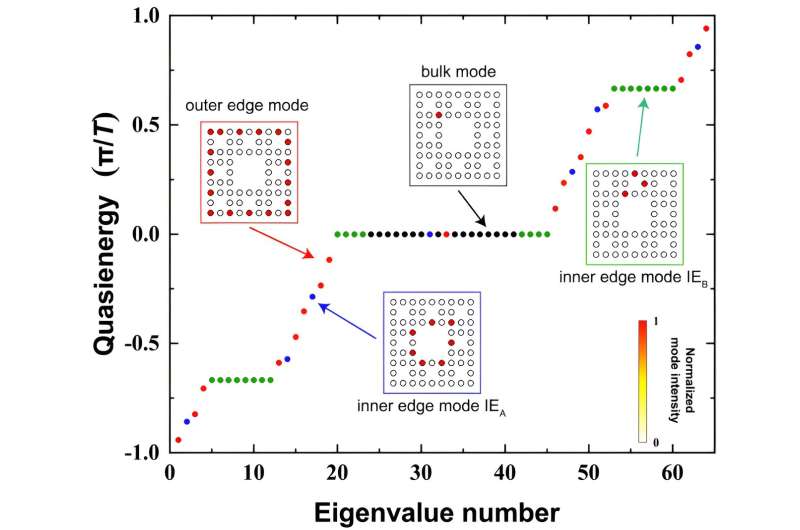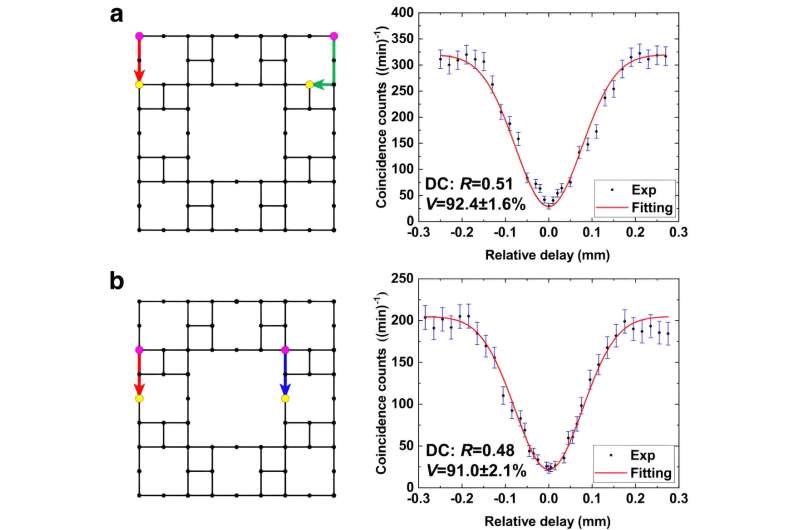An anomalous Floquet topological insulator (AFTI) is a periodically driven topological insulator (TI with nonzero winding numbers to support topological edge modes, though its standard topological invariants like Chern numbers are zero.
The photonic lattice constructed by an optical waveguide array fabricated by the femtosecond laser direct writing (FLDW) is an important platform for quantum simulation to realize photonic AFTIs, because the FLDW offers flexible design of true three-dimensional (3D) waveguide structures and precise control of each coupling between waveguides. Moreover, the evolution distance of the lattice can be mapped as the evolution time.
In femtosecond-laser-direct-written photonic AFTIs, selective coupling of adjacent waveguides in a cycle is explicitly defined by the discrete periodically driving protocol. At the complete transfer discrete driving protocol, chiral edge modes co-exist with dispension-less bulk modes, and the lattice energy transfer efficiency of the chiral edge mode is the highest among all TIs (close to 100%), so it is very suitable for the transport of fragile quantum states.
However, most photonic AFTIs usually support only one kind of chiral edge mode even at a large lattice size, exhibiting just one chirality and only propagating along the outer boundaries of lattices, which can’t meet the requirement of the scalability for the multi-state topological quantum system and the large-scale optical quantum computation. How to increase the type and number of chiral edge modes in a single photonic lattice is a challenge.

Recently, in a paper published in Light: Science & Applications, a team of scientists, led by Professor Yan Li and Professor Qihuang Gong from State Key Laboratory for Artificial Microstructure and Mesoscopic Physics, School of Physics, Peking University, China, and co-workers introduced the fractal into photonic AFTIs and have demonstrated the first experimental realization of fractal photonic AFTIs in glass using the FLDW technique.
The lattice sites are arranged according to the second-generation (G(2)) dual Sierpinski carpet (DSC) structure, whose Hausdorff dimension is 1.89D. The coupling between adjacent waveguides is configured according to the complete transfer discrete driving protocol: in each step, only one kind of coupling is switched on when two waveguides approach close to form a horizontal or vertical directional coupler (DC) and the other three are off, and the theoretical transmittivity of each DC is set as 100%.
The individual couplings are guaranteed by the specially designed 3D waveguide structure based on DCs, quite different from the previous fractal lattices constructed by identical straight waveguides or helical waveguides. In the fabricated one-period fractal AFTI samples, the number of DCs is up to 88, but less than that in a complete lattice.
It can be found in the quasienergy spectrum of the DSC lattice at G(2), the fractal lattice retains the chiral outer edge mode in the original normal lattice, and generates two chiral inner edge modes IEA and IEB, which have the opposite chirality with the outer edge mode and propagate along the inner boundaries of the lattice. The fractal AFTI with fewer waveguides supports 4 kinds of modes: 17 outer edge modes, 7 inner edge modes IEA, 24 inner edge modes IEB and 16 bulk modes. Thus, the number of chiral edge modes carried by a single lattice increases greatly to 48.
By single-site excitation of laser, though there exist coupling strength deviations in the fabricated sample, the measured mode transfer behaviors of chiral edge modes agree well with the theoretical simulation results, indicating the robustness of the chiral edge mode.
Furthermore, when the excited light is a pair of correlated photons, the generated single-photon chiral outer edge state and inner edge state are topologically protected in modes distribution and quantum correlation during the quantum state transport in the lattice. The observed high-visibility quantum interferences verify that multiple propagating single-photon chiral edge states are highly indistinguishable, which provide the potential for generating topologically protected entanglement resources and performing quantum logic operations.

“With the growth of fractal generations, the type and number of chiral edge modes in a single lattice increase significantly. When the injected photons are multi-photons, or photons in superposition states or entangled states, the quantum information capacity of a single fractal photonic lattice can be further expanded,” the researchers added.
“Fractal photonic AFTIs can simultaneously carry multiple topologically protected quantum chiral edge states, so they can serve as a stable carrier for high-capacity quantum information transmission. It is expected that they can be used in scalable multi-photon topological quantum computation and quantum simulation of multi-particle systems. In addition to the Sierpinski carpet and Sierpinski gasket, this can extend to many other fractal structures, which can broaden the field of fractal photonic TIs,” the scientists say.
More information:
Meng Li et al, Fractal photonic anomalous Floquet topological insulators to generate multiple quantum chiral edge states, Light: Science & Applications (2023). DOI: 10.1038/s41377-023-01307-y
Citation:
Fractal photonic anomalous Floquet topological insulators to generate multiple quantum chiral edge states (2023, December 7)
retrieved 11 December 2023
from
This document is subject to copyright. Apart from any fair dealing for the purpose of private study or research, no
part may be reproduced without the written permission. The content is provided for information purposes only.

